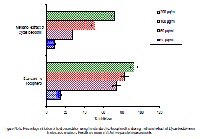In-vitro antioxidant activity of Cycas beddomei
Keywords:
Cycas beddomei, α-tocopherol, curcumin, vitamin E, CycadaceaeAbstract
The current study was to investigate antioxidant activity of methanol extract of whole plant of Cycas beddomei was administrated by utterly diverse models like DPPH radical scavenging assay, superoxide anion assay, nitric oxide radical inhibition assay, thiocyanate methodology, lipid peroxidation assay and hydroxyl radical scavenging assay. Methanol extract of Cycas beddomei showed effective antioxidant activity compared to straightforward antioxidants like ascorbic acid, rutin, curcumin, fat-soluble vitamin (Vitamin E) and α-tocopherol. The antioxidant activity depends upon the concentration and it had been increased with escalating the concentration of extract. The antioxidant activity could also be endorsed to the occurrence of phenolic and flavonoids compounds gift within the methanol extract. The results obtained within the present study point out that the methanol extract of whole plant of Cycas beddomei area unit a possible supply of natural antioxidant.
References
Cowan MM. “Plant products as antimicrobial agents”. Clin Microbiol Rev., 1999; 12: 564-582.
Gori M & Campbell RK. “Natural products and diabetes treatment”. Diabetes Educ., 1998; 24(2):201-2, 205-8.
Rao BRP, Babu MVS, Donaldson J. “A Reassessment of the Conservation Status of Cycas beddomei Dyer (Cycadaceae), an Endemic of the Tirupati – Kadapa hills, Andhra Pradesh, India, and comments on its CITES status”. Encephalartos., 2010; 102:19-24.
Jain SK and ARK. Sastry ARK. “Threatened Plants of India”. A State-of-the Art Report. 1980; 40.
Nayar MP, Sastry ARK. “Red Data Book of Indian Plants”, Botanical Survey of India, Calcutta. 1987; 359.
Selvam ABD. “Cycas beddomei Dyer. Pharmacognosy of negative listed plants. Botanical Survey of India”. Ministry of Environment and Forest., 2012; 49.
Latheef SA, Prasad B, Bavaji M, Subramanyam G. “A database on endemic plants at Tirumala hills in India”. Bioinformation., 2008; 2(6): 260-262.
Alekhya C, Yasodamma Nand Chaithra D. “Anti-inflammatory activity of Cycas beddomei Dyer. male cone extracts”. Indo American Journal of Pharmaceutical research., 2014; 4(01): 132-137.
Mahendra Nath M, Sankara Rao M, Ramesh L, Madhava Chetty K. “Phyto-chemical evaluation and anti-oxidant potentiality of Cycas beddomei Dyer male cone aqueous extract”. International Journal of Drug Delivery and Research., 2014; 6 (2): 220-227.
Alekhya C, Yasodamma Nand Chaithra D. “Antibacterial and physico-chemical studies of Cycas beddomei dyer, male and female cones”. International Journal of Pharma and Bio Sciences., 2013; 4(2): 647-656.
Prance GT and Mori SA. “Annals of the Missouri Botanical Garden”. 1986; 73: 99-101.
Harborne JB. “A Guide to modern techniques of plant analysis”. Phytochemical methods”. 1st ed. 1973; 1–80, 89–115. London: Chapman and Hall.
Matos FJA. “Introducao a fitoquimica experimental. Ceara”: Universidade do Ceara. 1988; 37–65.
Bonina F, Saija A, Lo Cascio R, Rapisarda P, Dederen JC. “In vitro antioxidant activity and in vivo photoprotective effect of a red orange extract”. Inti. J. Cos. Sci.,1988; 20: 331-342.
Sreejayan Rao MNA. “Nitric oxide scavenging by curcuminoids”. J. Pharm. Pharmacol., 1997; 49:105-107.
Green LC, Wagner DA, Glogowiski J, Skipper PL, Wishnok JS, Tannenbaum SR. “Analysis of nitrate, nitrite and nitrate (1SN) in Biological fluids”. Analytical Biochem. 126: 131, 1982.
McCord JM, Fridovich I. “Superoxide dismutase, an enzymatic function for erythrocuprein”. J. Biol. Chem., 1969; 244: 6049-6055.
Robak J, Gryglewski RJ. “Flavonoids are scavengers of superoxide anions”. Biochem. Pharmacol., 1988; 37(5): 837-841.
Ohkawa I, Ohishi N, Yagi K. “Assay for lipid peroxides in animal tissue by thiobarbituric acid reaction”. Anal. Biochem., 1979; 95: 351-358.
Yen GH, Chen HY. “Antioxidant activity of various tea extracts in relation to their antimutagenicity”. J Agric Food Chem., 1995; 43: 27-32.
Yildirim A, Mavi A, Kara AA. “Determination of antioxidant and antimicrobial activities of Rumex crispus L, extracts”. J Agric Food Chem 2001; 49: 4083-4089.
Halliwell B, Gutteridge JMC and Aruoma OI. The deoxyribose method: a simple ‘test tube’ assay for determination of rate constants for reaction of hydroxyl radicals. Analytical Biochem., 1987; 165: 215-219.
Nishimiki M, Rao NA, Yagi K. “The occurrence of superoxide anion in the reaction of reduced phenazine mehosulphate and molecular oxygen”. Biochem Biophysic Res Commun., 1972; 46: 849-853.
Bouchet N, Barrier L, Fauconneau B. “Radical scavenging activity and antioxidant properties of tannins from Guiera senegalensis (Combretaceae)”. Phytotherapy Res., 1998; 12:159-162.
Halliwell B, Gutteridge JMC. Oxygen toxicity, oxygen radicals, transition metals and diseases. Biochem J., 1984; 219: 1–14.
Rose WM, Creighton MO, Stewart DHPJ, Sanwal M, Trevithick GR. Modelling cortical cataractogenesis lll: “In vivo effects of vitamin E on cataract genesis in diabetic rats”. Can J Ophthalmol., 1982; 17: 61-66.
Aruoma OI, Cuppett SL. “Antioxidant methodology In vivo and In vitro concepts”, AOCS press, Champaign, Illinois; 1997; 41-172.
Rice- Evans C, Halliwell B, Lunt GG. “Free radicals and oxidative stress: Environment, Drugs and Food additives, 2nd edition, Portland press: London. root of Macrothelypteris torresiana (Gaud.) Ching”. Chinese Chem Lett., 1995; 208:15–816.
Thabrew MI, Joice PDTM, Rajatissa WA. “Comparative study of the efficacy of Paetta indica and Osbeckia octandra in the treatment of liver dysfunction”. Planta Med., 1987; 53: 239-241.
Badami S, Moorkoth S, Rai SR, Elango K and Suresh B. “Antioxidant activity of Aesalpinia sappan heartwood”. Biol. Pharma. Bull., 2003; 26 (11): 1534-1537.
Aruoma OI. “Characterization of drugs antioxidant prophylactics”. Free Rad Biol Med., 1996; 20(5): 675-705.
Kosugi H, Kato T and Kikugava K. “Formation of yellow, orange and red pigments in the eaction of alk-2-enals with 2-thiobarbituric acid”. Analytical Biochem., 1987; 165: 456-464.
Hemanth R, Jadav and Bhutani KK. “Antioxidant properties of Indian medicinal plants”. Phytotheraphy Res., 2002; 16: 771-773.
Haribal M, Renwick J, Alan A. “Oviposition stimulants for the monarch butterfly: flavonol glycosides from Asclepias curassavica”. Phytochemistry., 1996; 41(1): 139-144.
Halliwell B, Gutteridge JMC and Aruoma OI. “The deoxyribose method: a simple ‘test tube’ assay for determination of rate constants for reaction of hydroxyl radicals”. Analytical Biochem., 1987; 165: 215-219.
Sen T, Dhara AK, Bhattacharjee S, Pal S, Nag Chaudhuri AK. “Antioxidant activity of the methanol fraction of Pluchea indica root extract”. Phytotherapy Res 2002; 16: 331-335.



